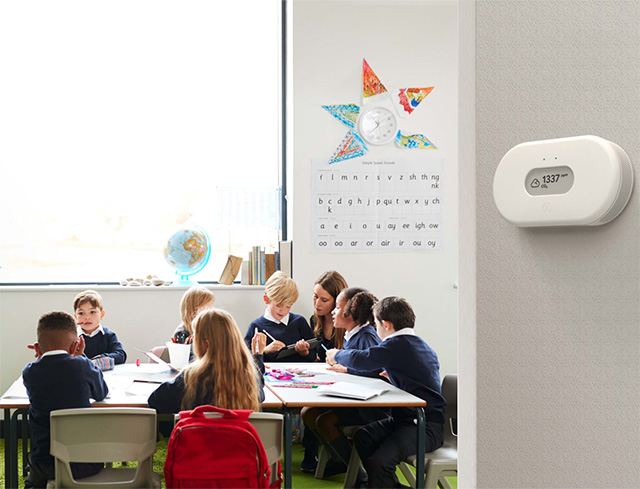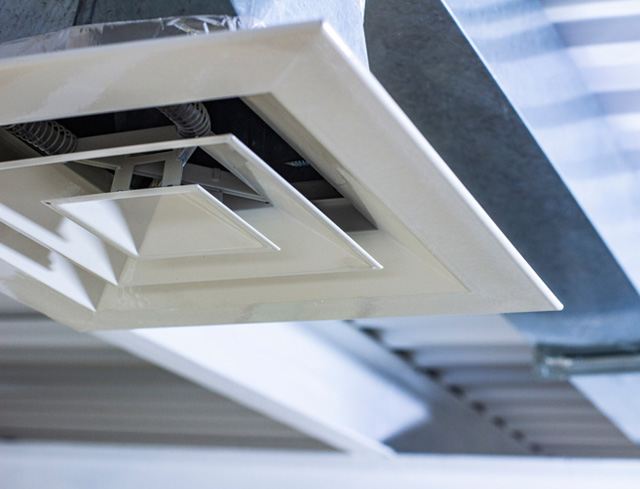
Ventilation
 The role of CO2 monitoring
The role of CO2 monitoring
We release CO2 when we breathe out, so higher levels of CO2 in a room are related to higher occupancy and lower ventilation rates. As high levels of CO2 indicate that an indoor space is poorly ventilated, it is important to know when levels of this gas, which we all exhale 24,000 times a day, are high, so you can take action and increase ventilation as levels begin to rise.
Sensors can be used to monitor levels of CO2 and some of the better ones, alert room occupants when levels are too high. There are also some monitors that include a range of sensors to monitor CO2 and other air pollutants like particulate matter (PM), volatile organic compounds (VOCs) and Radon all of which are harmful to health in their own right. By also monitoring environmental factors like humidity, temperature and air pressure some innovative companies have developed algorithms that detect when the risks of virus transmission or the development of mould are high.
We recently published the results of a year long, live study on CO2 levels in classrooms which can be downloaded here.
Opening windows
It is difficult to filter out CO2, and currently CO2 scrubbers are large scale, expensive and unattainable. So, if levels of this gas are high (above 1500ppm), ventilation should be increased by turning up mechanical ventilation systems or opening doors and windows. This mixes outdoor air with stale indoor air, diluting CO2, other pollutants and viruses circulating in the air. If the opening of windows and doors is the only means of ventilation then try to create a cross-flow of air by opening windows and doors on opposite sides of the room. The air pressure difference between the windows causes a cross breeze, pulling fresh air in on one side and pushing stale air out on the other. Exhaust fans can also help to draw stale air from the room and increase the flow of fresh air through open windows.
Poorly ventilated spaces and how air purifiers can help
Much of the schools’ estate in the UK is made up of poorly maintained, old building stock that doesn’t have the luxury of mechanical ventilation. Over the years these buildings have been made more air tight to reduce energy consumption and related costs, but often ventilation has been overlooked. As a result, many schools have no adequate means of ventilation other than to open windows and doors.
In these cases, air purification units can help to clean the air indoors in the short term, until mechanical or natural ventilation is improved. Professor Mark Mon-Williams and Professor Catherine Noakes have created a 10-point guide to support schools in understanding the role of air cleaning technology and how they can be deployed most effectively within classroom settings.
 Mechanical ventilation
Mechanical ventilation
Mechanical ventilation systems are often called heating, ventilation and air conditioning (HVAC) systems as they are able to heat or cool the incoming air, ensuring indoor environments are optimised for comfort, as well as the health and wellbeing of building occupants. A note of caution here – not all AC systems are able to introduce fresh air to the mix as they are only intended to recirculate and cool indoor air.
These systems are managed by a building management system (BMS) and when air quality monitors are integrated with the BMS, lighting, temperature and ventilation levels can be automatically adjusted per room or zone. This way of managing modern HVAC systems also ensures that when parts of the building are not in use (very low levels of CO2) energy can be reduced by automatically turning off lights and reducing heating or cooling in that part of the building.
The outdoor air brought in by the HVAC is also filtered as well as being heated or cooled and it should be noted here that the better the filters, the harder the fans need to work, increasing energy usage in the process. It is important that filters are replaced regularly to maintain good air quality. If filters are not appropriately maintained, they can become saturated leading to increased pollutant levels, potential microbial growth and odours and higher virus transmission risk.
Natural building ventilation
Buildings can still have a natural ventilation system installed, and many designers are choosing natural ventilation strategies for new buildings, to help reduce a building’s reliance on energy for ventilation, therefore improving the building’s sustainability profile. Windows, louvres and roof stacks can all be automated and managed by the BMS that takes real-time data from air quality monitoring sensors. Buildings in high pollution belts or in densely built up areas are not usually suitable for a natural ventilation strategy as outdoor pollution can be brought into the building.
Whichever ventilation strategy you use it must be proven to work and regularly tested, and this is where air quality sensors come in once again, as they monitor the air 24/7, and CO2 levels will indicate if the ventilation system is working to the required level.
Note: In areas with high pollution levels some ventilation methods – like the opening of windows – may allow the ingress of outdoor pollutants like NO2, VOCS and PM. In these instances, air purifiers are advised as a short term solution until the ventilation system is improved. Air purification units should incorporate a HEPA13 filter as a minimum, that will capture 99.9 percent of particulate matter down to 1µg/m³ (micrograms per cubic meter of air), and also uses a high grade activated carbon filter to reduce VOCs and NO2. Air purifiers cannot filter out CO2 so it’s important that ventilation is improved in the long term.


